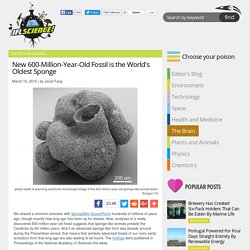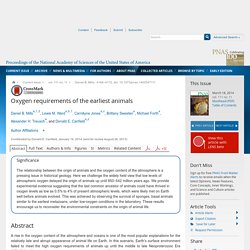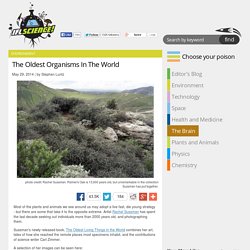

Evolution Once Operated Thousands Of Times Faster. The first life forms had mutation rates 4,000 times faster than we see today, biologists have estimated, meaning astonishingly fast evolution.

Popular culture attributes mutations to radiation and toxic slime, but spontaneous mutations are also important. Most spontaneous genetic mutations are caused by cytosine deamination, the loss of an amine group (simple nitrogen-containing hydrocarbons) from cytosine, one of the four bases that make up DNA's alphabet of life. The process turns cytosine to thymine, transforming the DNA code and altering the proteins produced. The rate of cytosine deamination rises with temperature. Since life first appeared on Earth at a time when temperatures were higher, mutation should have been more frequent. Scientists may have found the earliest evidence of life on Earth. When did life on Earth begin?

Scientists have dug down through the geologic record, and the deeper they look, the more it seems that biology appeared early in our planet’s 4.5-billion-year history. So far, geologists have uncovered possible traces of life as far back as 3.8 billion years. Now, a controversial new study presents potential evidence that life arose 300 million years before that, during the mysterious period following Earth’s formation. The clues lie hidden in microscopic flecks of graphite—a carbon mineral—trapped inside a single large crystal of zircon. Scientists Discover Enormous Sea Scorpion. Millions of years ago, something nightmarish scuttled along the ocean floor, something that we have only recently found any evidence of.

And its fossil is monstrous. An ancient, giant sea scorpion, measuring over 1.5 meters (5 feet) long. Its closest modern relatives are the arachnids, such as the house spider. The fossil dates back 460 million years, which makes it the oldest known sea scorpion (eurypterid). It has been named Pentecopterus decorahensis. This incredible specimen has been identified using more than 150 fossil fragments. New 600-Million-Year-Old Fossil is the World's Oldest Sponge.
We shared a common ancestor with SpongeBob SquarePants hundreds of millions of years ago, though exactly how long ago has been up for debate.

Now, analyses of a newly discovered 600-million-year-old fossil suggests that sponge-like animals predate the Cambrian by 60 million years. And if an advanced sponge-like form was already around during the Precambian period, that means that similarly advanced fossils of our (very early) ancestors from that long ago are also waiting to be found.
The findings were published in Proceedings of the National Academy of Sciences this week. Previous studies have suggested that the last common ancestor shared by animal sponges and almost all other animals—called eumetazoans, which includes people and clams alike—existed more than 200 million years before the Cambrian period began around 541 million years ago. Unfortunately, unequivocal fossil evidence of this common ancestor is scant. Read this next: Love Hormone Oxytocin Helps Men Eat Better. Scientists Discover Microbes That Have Remained Essentially Unchanged For 2 Billion Years. A team of scientists has discovered a remarkable type of deep-sea bacterium that appears to have remained essentially unchanged for over 2 billion years.

Hydrogen-Rich Waters May Support Life Far Underground. Some of the most ancient rocks on Earth have been found to host water that is rich in hydrogen.

The chemistry is similar to that around deep ocean vents, candidates for the birthplace of life, and the discovery could open up new opportunities to explore what is known as the deep carbon cycle. Professor Barbara Sherwood Lollar of the University of Toronto has explored deep Precambrian shield rocks in Canada, South Africa and Scandinavia, and reports evidence for hydrogen-rich waters, sometimes containing 30% hydrogen by volume. In Nature, she explains the hydrogen's presence is not primarily from radioactivity as previously thought, but as the product of chemical reactions. The presence of hydrogen in these environments is important because, as previous studies have shown, it can provide a source of energy that allows microbial communities to thrive—whether at hydrothermal vents or in rocks reached by South Africa's deepest gold mines. Sherwood Lollar et al. Oxygen requirements of the earliest animals.
Author Affiliations Contributed by Donald E.

Canfield, January 14, 2014 (sent for review August 26, 2013) Significance. The Oldest Organisms In The World. Most of the plants and animals we see around us may adopt a live fast, die young strategy - but there are some that take it to the opposite extreme.

Artist Rachel Sussman has spent the last decade seeking out individuals more than 2000 years old, and photographing them. Sussman's newly released book, The Oldest Living Things in the World combines her art, tales of how she reached the remote places most specimens inhabit, and the contributions of science writer Carl Zimmer. A selection of her images can be seen here: Most of Sussman's examples survive in harsh environments where a lack of warmth or nutrients make growth a very slow business.
In this class is the La Laretea (Azorella compacta) plants of the Atacama Desert, Peru. Antarctic mosses such Chorisodontium aciphyllum grow even more slowly, just centimeters in centuries and have been revived after a millennium and a half in frozen suspended animation. As Sussman points out, these species are more than mere curiosities. Mars Curiosity rover finds evidence of ancient lakes in Gale crater.